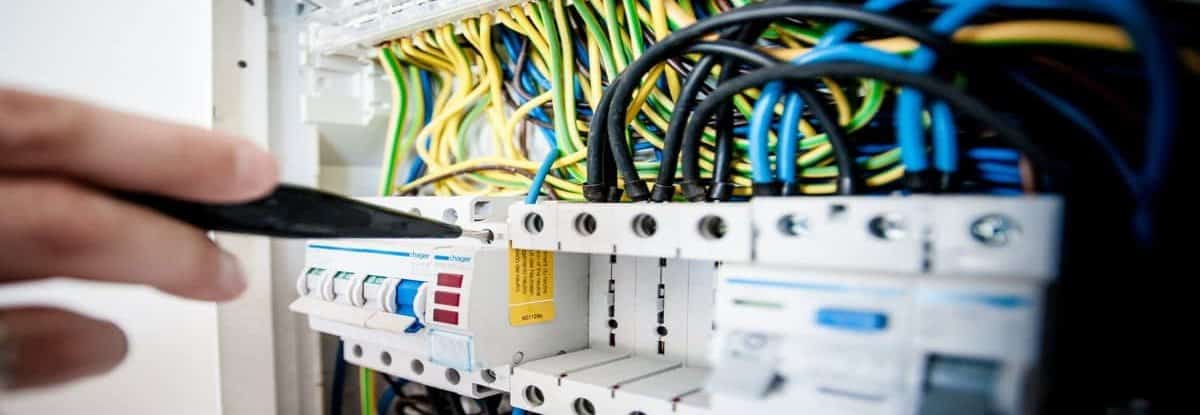Have you ever opened up your switchboard and wondered what is going on in there?
Are you curious as to what everything does and how it protects you? Let’s take a look inside the standard New Zealand switchboard and identify some common features and what you should look out for.
Common components of switchboards
Rewirable Fuse:
A very common component of older switchboard fuses function by allowing electrical current to flow through a thin fuse wire and power the circuit. The fuse wire can handle a certain amount of current up to a specific point (E.g. 10amps) and once this limit has been surpassed the fuse wire will melt and break the flow of electricity. This usually happens if the circuit is being overloaded or if a short circuit occurs. Homeowners can replace the fuse wire in these fuses but make sure you use the correctly rated fuse wire. Lighting circuits use fuse wire up to 10A and power circuits use up to 15A. Always make sure you have turned the power off at the main switch before doing this.
Circuit Breakers:
Circuit breakers were used to replace fuses as the next overload protection devices. The advantages circuit breakers have over fuses are their ability to be easily reset by flicking a switch or button rather than having to rewire a fuse, are more sensitive to current abnormalities, easier to identify faulty circuits and their reusability which saves on maintenance costs. Circuit breakers come in many forms, some of the more common forms include:
Miniature Circuit Breaker – Miniature Circuit breakers (More commonly known as MCBs) are the modern circuit breaker which provides overload protection while being more compact which takes up less space in the switchboard.
Circuit breaker – A very early form of circuit breaker can be identified by its large black casing and are genuinely much larger then there more modern MCB counterparts
Push button MCB – PB MCBs were used as a quick and cheap way to replace fuses by being a plug-in circuit breaker which still uses the fuse base. They operate the same way as a normal MCB but use a push button instead of a switch. Sometimes they have a little red button located on them which act as a test or reset button, these can from time to time get stuck and force the breaker to remain open so if you are trying to reset these breakers and it’s not working check to see if this is the case.
Plug-in MCB – Plug-in MCBs are the upgraded version of PB MCBs. They too use the original fuse base and provide an even easier reset function using a switch and have a quick identification for off or faulty circuits.
Residual Current Device:
Residual Current devices (More commonly known as RCDs) are Electrical safety devices which detect minute changes in current between the red phase and black neutral cables. When a difference in current is detected (usually caused by a leakage to earth due to an electrical fault) it causes the RCD to “Trip” and open causing power loss to that circuit. They add an extra layer of protection over normal MCBs because they can detect potentially dangerous fault currents that may not be large enough to overload the MCB instantly but still can cause harm or death to a person. They can be identified as an extra wide looking MCB with a test button on them.
Main Switch and Main Fuse:
The Main Switch and the Main fuse are the last line of protection on your standard switchboard and in theory, these should never trip or blow as the MCB or RCD protecting the circuit should trip before these do. They are mainly used to isolate power to your entire installation making it safe to perform basic electrical maintenance such as rewire fuses or replace light fittings or power sockets. The Fuse can be identified as a large black plastic fuse and the switch can either be a black or white plastic switch as seen in the photos above.
Smart Meter:
The smart meter tracks how much electricity your household is using and sends it wirelessly back to your power provider. Older models of electricity meter do not have this function and need to be read by a meter reader usually sent by your power provider.
Ripple Relay:
The ripple relay is used to switch power off for your hot water cylinder at critical times – like on cold winter nights when demand for electricity is highest and at times when faults mean less power is available in the local area. Usually, you won’t even notice when a ripple relay is in effect but there are some advantages to having one –
- About 30% of the energy in the average home is used for water heating
- Having controlled power usually saves you money on your power bill
- Controlling power helps to keep the electricity system reliable and lowers costs.
Hot Water Isolating Switch:
These are now an obsolete feature but are usually found on older boards. They are switches which allow you to isolate power to your hot water cylinder. Current electrical standards stipulate that your hot water cylinder must have a local isolating switch (Meaning it must be near your HWC) rather than at the board.
That concludes the basic rundown of what you can find in your average domestic household switchboard but there are other things you can look out for. In some cases, you may notice your old switchboard may have a black panel with which the switchboard components are mounted to. This black panel is made of ACM (asbestos containing material) and on its own is harmless if undisturbed. Unfortunately, if a future electrician needs to install a new circuit and/or protective gear they would be unable to due to the health risk the ACM board can cause if drilling is required. If you notice this material on your switchboard and an electrician comes to do work at your place you may be asked to upgrade your board before they can do any work on it.
As far as things homeowners can do with their switchboards there are only two ways you can interact with them. One way is to reset tripped MCBs and RCDS as well as turn off the main switch to perform basic electrical maintenance such as replacing a light fitting or broken socket, another way you can interact with your board is to replace blown fuse wire with the equivalently rated wire. As with everything electrical If you are unsure or worried about anything you see in your board or what you can do with your board contact an electrician today to take a look and investigate or take a look at our switchboard upgrading service here.
If you have an electrical maintenance issue, a renovation project or just want to find out more about how we can help you – don’t hesitate to give us a call, send us an email or fill in the form below. We’ll get back to you without delay.




